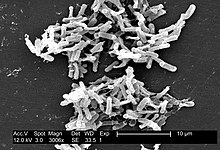
A | B | C | D | E | F | G | H | CH | I | J | K | L | M | N | O | P | Q | R | S | T | U | V | W | X | Y | Z | 0 | 1 | 2 | 3 | 4 | 5 | 6 | 7 | 8 | 9
| Clostridioides | |
|---|---|

| |
| SE micrograph of Clostridioides difficile colonies from a stool sample | |
| Scientific classification | |
| Domain: | Bacteria |
| Phylum: | Bacillota |
| Class: | Clostridia |
| Order: | Eubacteriales |
| Family: | Peptostreptococcaceae |
| Genus: | Clostridioides Lawson and Rainey (2016) |
| Selected species | |
Clostridioides is a genus of Gram-positive bacteria, which includes Clostridioides difficile, a human pathogen causing an infectious diarrhea.
Taxonomy
The genus Clostridioides was created to describe a few species formerly in the genus Clostridium which have been shown to be their own genetically distinct genus using 16S rRNA gene sequencing analysis.[1] However, both names are still in use and valid under the International Code of Nomenclature of Prokaryotes.[2] Since C. mangenotii was further separated into a distinct genus in 2024,[3] Clostridioides is a monotypic genus.
Description
They are obligate anaerobes capable of producing endospores. The normal, reproducing cells of Clostridioides, called the vegetative form, are rod-shaped, which gives them their name, from the Greek κλωστήρ or spindle. Clostridioides endospores, like Clostridium endospores, have a distinct bowling pin or bottle shape, distinguishing them from other bacterial endospores, which are usually ovoid in shape.[citation needed]
References
- ^ Lawson, Paul A.; Citron, Diane M.; Tyrrell, Kerin L.; Finegold, Sydney M. (August 2016). "Reclassification of Clostridium difficile as Clostridioides difficile (Hall and O'Toole 1935) Prévot 1938". Anaerobe. 40: 95–99. doi:10.1016/j.anaerobe.2016.06.008. PMID 27370902.
- ^ Oren, Aharon; Rupnik, Maja (August 2018). "Clostridium difficile and Clostridioides difficile: Two validly published and correct names". Anaerobe. 52: 125–126. doi:10.1016/j.anaerobe.2018.07.005. PMID 30031828. S2CID 51707574.
- ^ Bello, Sarah; McQuay, Sarah; Rudra, Bashudev; Gupta, Radhey (2024). "Robust demarcation of the family Peptostreptococcaceae and its main genera based on phylogenomic studies and taxon-specific molecular markers". International Journal of Systematic and Evolutionary Microbiology. 74 (2). doi:10.1099/ijsem.0.006247. PMID 38319314.
Text je dostupný za podmienok Creative Commons Attribution/Share-Alike License 3.0 Unported; prípadne za ďalších podmienok. Podrobnejšie informácie nájdete na stránke Podmienky použitia.
Antropológia
Aplikované vedy
Bibliometria
Dejiny vedy
Encyklopédie
Filozofia vedy
Forenzné vedy
Humanitné vedy
Knižničná veda
Kryogenika
Kryptológia
Kulturológia
Literárna veda
Medzidisciplinárne oblasti
Metódy kvantitatívnej analýzy
Metavedy
Metodika
Text je dostupný za podmienok Creative
Commons Attribution/Share-Alike License 3.0 Unported; prípadne za ďalších
podmienok.
Podrobnejšie informácie nájdete na stránke Podmienky
použitia.
www.astronomia.sk | www.biologia.sk | www.botanika.sk | www.dejiny.sk | www.economy.sk | www.elektrotechnika.sk | www.estetika.sk | www.farmakologia.sk | www.filozofia.sk | Fyzika | www.futurologia.sk | www.genetika.sk | www.chemia.sk | www.lingvistika.sk | www.politologia.sk | www.psychologia.sk | www.sexuologia.sk | www.sociologia.sk | www.veda.sk I www.zoologia.sk
